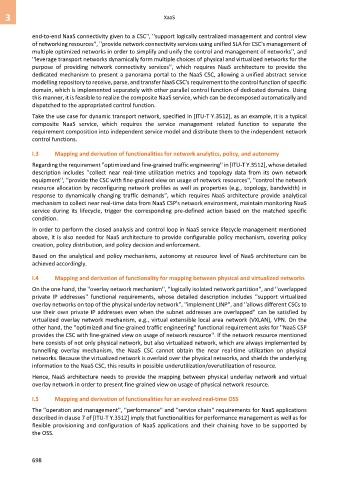Page 706 - Cloud computing: From paradigm to operation
P. 706
3 XaaS
end-to-end NaaS connectivity given to a CSC'', ''support logically centralized management and control view
of networking resources'', ''provide network connectivity services using unified SLA for CSC's management of
multiple optimized networks in order to simplify and unify the control and management of networks'', and
''leverage transport networks dynamically form multiple choices of physical and virtualized networks for the
purpose of providing network connectivity services'', which requires NaaS architecture to provide the
dedicated mechanism to present a panorama portal to the NaaS CSC, allowing a unified abstract service
modelling repository to receive, parse, and transfer NaaS CSC's requirement to the control function of specific
domain, which is implemented separately with other parallel control function of dedicated domains. Using
this manner, it is feasible to realize the composite NaaS service, which can be decomposed automatically and
dispatched to the appropriated control function.
Take the use case for dynamic transport network, specified in [ITU-T Y.3512], as an example, it is a typical
composite NaaS service, which requires the service management related function to separate the
requirement composition into independent service model and distribute them to the independent network
control functions.
I.3 Mapping and derivation of functionalities for network analytics, policy, and autonomy
Regarding the requirement ''optimized and fine-grained traffic engineering'' in [ITU-T Y.3512], whose detailed
description includes ''collect near real-time utilization metrics and topology data from its own network
equipment'', ''provide the CSC with fine-grained view on usage of network resources'', ''control the network
resource allocation by reconfiguring network profiles as well as properties (e.g., topology, bandwidth) in
response to dynamically changing traffic demands'', which requires NaaS architecture provide analytical
mechanism to collect near real-time data from NaaS CSP's network environment, maintain monitoring NaaS
service during its lifecycle, trigger the corresponding pre-defined action based on the matched specific
condition.
In order to perform the closed analysis and control loop in NaaS service lifecycle management mentioned
above, it is also needed for NaaS architecture to provide configurable policy mechanism, covering policy
creation, policy distribution, and policy decision and enforcement.
Based on the analytical and policy mechanisms, autonomy at resource level of NaaS architecture can be
achieved accordingly.
I.4 Mapping and derivation of functionality for mapping between physical and virtualized networks
On the one hand, the ''overlay network mechanism'', ''logically isolated network partition'', and ''overlapped
private IP addresses'' functional requirements, whose detailed description includes ''support virtualized
overlay networks on top of the physical underlay network'', ''implement LINP'', and ''allows different CSCs to
use their own private IP addresses even when the subnet addresses are overlapped'' can be satisfied by
virtualized overlay network mechanism, e.g., virtual extensible local area network (VXLAN), VPN. On the
other hand, the ''optimized and fine-grained traffic engineering'' functional requirement asks for ''NaaS CSP
provides the CSC with fine-grained view on usage of network resource''. If the network resource mentioned
here consists of not only physical network, but also virtualized network, which are always implemented by
tunnelling overlay mechanism, the NaaS CSC cannot obtain the near real-time utilization on physical
networks. Because the virtualized network is overlaid over the physical networks, and shields the underlying
information to the NaaS CSC, this results in possible underutilization/overutilization of resource.
Hence, NaaS architecture needs to provide the mapping between physical underlay network and virtual
overlay network in order to present fine-grained view on usage of physical network resource.
I.5 Mapping and derivation of functionalities for an evolved real-time OSS
The ''operation and management'', ''performance'' and ''service chain'' requirements for NaaS applications
described in clause 7 of [ITU-T Y.3512] imply that functionalities for performance management as well as for
flexible provisioning and configuration of NaaS applications and their chaining have to be supported by
the OSS.
698

